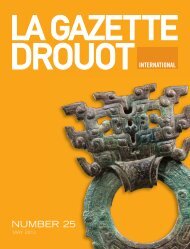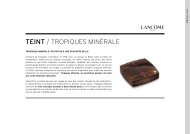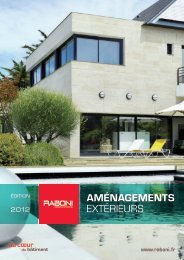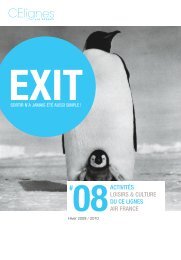Art Market Magazine - Visit zone-secure.net
Art Market Magazine - Visit zone-secure.net
Art Market Magazine - Visit zone-secure.net
Create successful ePaper yourself
Turn your PDF publications into a flip-book with our unique Google optimized e-Paper software.
THE MAGAZINE DECIPHERING<br />
Daum a hymn to Nature<br />
With the arrival of the industrial era in<br />
the 19th century, urban development<br />
ran riot, driving populations<br />
together in chaotic suburbs where<br />
machines churned away endlessly,<br />
and factory chimneys rose up against the skies, obscuring<br />
them with billows of smoke. Banished from the<br />
world of men, beauty took refuge in nature. And that<br />
was where it now had to be sought out. And so well-todo<br />
households sprouted winter gardens, where every<br />
care was lavished on the plants, while public<br />
glasshouses provided a home for exotic specimens, to<br />
the delight of visitors. The Nancy botanical garden,<br />
which inherited a plant collection at the end of the<br />
17th century, was the pride of the city, famous for its<br />
horticulture all over the world. The work of its director,<br />
Dominique Alexandre Godron, who taught Émile Gallé,<br />
largely inspired the artist's plant collections. And this<br />
was the start of something new: from then on, flowers<br />
would blossom on glass. The capital of Lorraine<br />
provided particularly fertile soil for a naturalistic<br />
movement, but this movement was already taking<br />
hold throughout the country. Saturated with the<br />
aesthetic of the Ancien Régime, the subject of extravagant<br />
pastiche in the first half of the 19th century, the<br />
high priests of <strong>Art</strong> Nouveau took exactly the opposite<br />
stance, where nature bent rigorously constructed lines,<br />
the East became a new yardstick, and symbolism<br />
opened the way to another reality. The decorative arts<br />
plunged into the gulf of non-conformism – no doubt<br />
too enthusiastically, as "overkill" always lurks behind<br />
any stylistic excess... And <strong>Art</strong> Nouveau succumbed to it<br />
in a few years. However, numerous achievements bear<br />
witness to the marvels of inventiveness and technical<br />
102 GAZETTE DROUOT INTERNATIONAL I N° 23<br />
sophistication deployed by the innovative aesthetic,<br />
whose apogee was celebrated in the Exposition<br />
Universelle of 1900. A year later, in support of this<br />
dynamic movement, Émile Gallé instigated an alliance<br />
between professionals: the Ecole de Nancy, where<br />
science, industry and marketing (far ahead of its time)<br />
married well with the arts. The Daum brothers –<br />
Auguste the lawyer and Antonin the engineer – were<br />
part of this venture. Antonin, completely enchanted by<br />
Gallé's works, which he discovered in the Exposition<br />
Universelle of 1889, decided to broadly disseminate<br />
the naturalistic style through his own creations. In the<br />
glassworks bought by their father in 1878, the two<br />
brothers began to redirect production towards a more<br />
artistic expression, through a decoration workshop<br />
they opened in 1891. Aided by the latest discoveries in<br />
chemistry, colour was introduced into designs, and the<br />
factory rapidly became the leading edge of technical<br />
innovation in glass. The sector was all the more flourishing<br />
at the time in that decorative objects, flaunted as<br />
a gauge of social success, had the wind in their sails.<br />
Apart from businessmen, Daum's aim was to attract a<br />
broader clientele of art lovers through a large quantity<br />
of high quality art glass objects. No fewer than three<br />
hundred workers laboured to this end between 1900<br />
and 1914. The company held a large number of<br />
exhibitions to present its most outstanding creations<br />
and advertise its innovations. These were regularly<br />
acclaimed with awards, for the brothers stopped at<br />
nothing to prove their virtuosity, combining<br />
techniques to transform glass and model it in the<br />
image of nature, the supreme yardstick for <strong>Art</strong><br />
Nouveau. Illusionism reached its height with a vase<br />
produced in 1905 in the form of a marrow with a
















